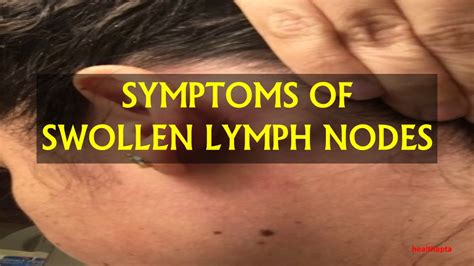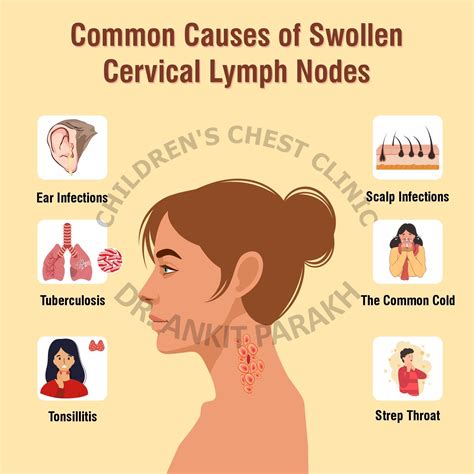Intro
Discover causes of swollen left lymph node, including infections, cancer, and autoimmune disorders, and learn about symptoms, diagnosis, and treatment options for lymphadenopathy and swollen lymph nodes.
The human body has a complex network of lymph nodes that play a crucial role in the immune system. Lymph nodes are small, bean-shaped structures that are located throughout the body, and they help to filter out harmful substances and fight off infections. When a lymph node becomes swollen, it can be a sign of an underlying health issue. A swollen left lymph node can be caused by a variety of factors, and it's essential to understand the possible causes to seek proper medical attention.
Swollen lymph nodes can occur in any part of the body, but when they occur on the left side, it can be particularly concerning. The left side of the body has a unique set of lymph nodes that drain into the thoracic duct, which is the main lymphatic vessel in the body. When the left lymph node becomes swollen, it can indicate a problem with the lymphatic system or an underlying infection. In some cases, a swollen left lymph node can be a sign of a more serious health issue, such as cancer or an autoimmune disorder.
The importance of understanding the causes of a swollen left lymph node cannot be overstated. By recognizing the possible causes, individuals can take steps to prevent and treat the underlying condition. Moreover, early detection and treatment can significantly improve outcomes and reduce the risk of complications. In this article, we will delve into the possible causes of a swollen left lymph node, discuss the symptoms and diagnosis, and explore the treatment options available.
Causes of Swollen Left Lymph Node

A swollen left lymph node can be caused by a variety of factors, including infections, autoimmune disorders, and cancer. Some of the most common causes of a swollen left lymph node include:
- Viral infections, such as mononucleosis or influenza
- Bacterial infections, such as tuberculosis or strep throat
- Fungal infections, such as histoplasmosis or cryptococcosis
- Autoimmune disorders, such as rheumatoid arthritis or lupus
- Cancer, such as lymphoma or leukemia
- Injuries or trauma to the left side of the body
Types of Infections that Cause Swollen Left Lymph Node
Infections are one of the most common causes of a swollen left lymph node. When the body detects an infection, the lymph nodes become swollen as they work to filter out the harmful substances and fight off the infection. Some of the most common types of infections that cause a swollen left lymph node include: * Mononucleosis: a viral infection that causes fever, sore throat, and swollen lymph nodes * Tuberculosis: a bacterial infection that causes coughing, fever, and swollen lymph nodes * Strep throat: a bacterial infection that causes sore throat, fever, and swollen lymph nodes * Histoplasmosis: a fungal infection that causes fever, coughing, and swollen lymph nodesSymptoms of Swollen Left Lymph Node

The symptoms of a swollen left lymph node can vary depending on the underlying cause. Some of the most common symptoms include:
- Swelling or enlargement of the lymph node
- Pain or tenderness in the affected area
- Redness or inflammation of the skin over the affected area
- Fever or chills
- Fatigue or weakness
- Weight loss or loss of appetite
Diagnosis of Swollen Left Lymph Node
Diagnosing a swollen left lymph node requires a combination of physical examination, medical history, and diagnostic tests. Some of the most common diagnostic tests used to diagnose a swollen left lymph node include: * Blood tests: to check for signs of infection or inflammation * Imaging tests: such as X-rays, CT scans, or MRI scans to visualize the affected area * Biopsy: to examine the tissue of the affected lymph node * Physical examination: to check for signs of swelling, tenderness, or rednessTreatment Options for Swollen Left Lymph Node

The treatment options for a swollen left lymph node depend on the underlying cause. Some of the most common treatment options include:
- Antibiotics: to treat bacterial infections
- Antiviral medications: to treat viral infections
- Anti-inflammatory medications: to reduce swelling and pain
- Surgery: to remove the affected lymph node or to treat underlying conditions
- Radiation therapy: to treat cancerous lymph nodes
Home Remedies for Swollen Left Lymph Node
In addition to medical treatment, there are several home remedies that can help to reduce the symptoms of a swollen left lymph node. Some of the most common home remedies include: * Applying warm compresses to the affected area * Taking over-the-counter pain medications * Getting plenty of rest and staying hydrated * Eating a healthy diet rich in fruits, vegetables, and whole grains * Practicing stress-reducing techniques, such as meditation or deep breathingPrevention of Swollen Left Lymph Node

Preventing a swollen left lymph node requires a combination of good hygiene, a healthy lifestyle, and regular medical check-ups. Some of the most effective ways to prevent a swollen left lymph node include:
- Practicing good hygiene, such as washing hands regularly
- Getting vaccinated against common infections, such as flu or pneumonia
- Eating a healthy diet rich in fruits, vegetables, and whole grains
- Getting regular exercise and staying physically active
- Avoiding close contact with people who have infectious diseases
Risk Factors for Swollen Left Lymph Node
There are several risk factors that can increase the likelihood of developing a swollen left lymph node. Some of the most common risk factors include: * Weakened immune system * History of infections or autoimmune disorders * Family history of cancer or lymphoma * Exposure to toxins or chemicals * Poor diet or lifestyle habitsWhat are the most common causes of a swollen left lymph node?
+The most common causes of a swollen left lymph node include infections, autoimmune disorders, and cancer. Viral infections, such as mononucleosis or influenza, are common causes, as well as bacterial infections, such as tuberculosis or strep throat.
How is a swollen left lymph node diagnosed?
+A swollen left lymph node is diagnosed through a combination of physical examination, medical history, and diagnostic tests, such as blood tests, imaging tests, and biopsy.
What are the treatment options for a swollen left lymph node?
+The treatment options for a swollen left lymph node depend on the underlying cause and may include antibiotics, antiviral medications, anti-inflammatory medications, surgery, or radiation therapy.
Can a swollen left lymph node be prevented?
+Yes, a swollen left lymph node can be prevented by practicing good hygiene, getting vaccinated against common infections, eating a healthy diet, getting regular exercise, and avoiding close contact with people who have infectious diseases.
What are the risk factors for developing a swollen left lymph node?
+The risk factors for developing a swollen left lymph node include a weakened immune system, history of infections or autoimmune disorders, family history of cancer or lymphoma, exposure to toxins or chemicals, and poor diet or lifestyle habits.
In conclusion, a swollen left lymph node can be a sign of an underlying health issue, and it's essential to understand the possible causes to seek proper medical attention. By recognizing the symptoms, diagnosis, and treatment options, individuals can take steps to prevent and treat the underlying condition. We encourage readers to share their experiences and ask questions in the comments below. If you found this article informative, please share it with your friends and family to help spread awareness about the importance of lymph node health.
